OK, so after years of (off and on) writing about High Speed Rail, I’ve finally been on a High Speed Rail train … on the Beijing – Tianjin Intercity Railway. Though I have to say that I went to Tianjin by Subway and High Speed Rail, given that substantially more time was spent en-route on …
Tag: High Speed Rail
Jul 28 2014
Sunday Train: HSR from Houston to Dallas one step closer to reality
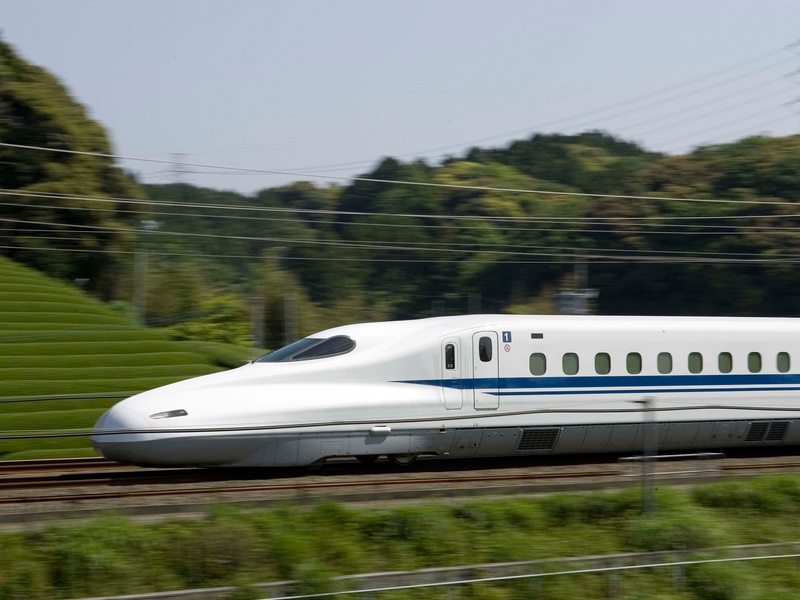 The Texas Department of Transport and Federal Railway Authority announced in June that they were beginning an Environmental Impact Study for the proposed private Texas Central Railways (TCR) High Speed Rail corridor between Houston and Dallas.
The Texas Department of Transport and Federal Railway Authority announced in June that they were beginning an Environmental Impact Study for the proposed private Texas Central Railways (TCR) High Speed Rail corridor between Houston and Dallas.
This is a private venture that is proposing to using the “Japan Rail Central” N700-I system, an internationalized version of the 186mph HSR train running between Tokyo and Osaka. TCR proposal is not only for the trains to be operated on farebox revenue, but for the corridor to be built with private funds. As the FRA announcement states:
TCR is a Texas-based company formed in 2009 to bring HSR to Texas as a private-sector venture. Working closely with Central Japan Railway Company (JRC), TCR is proposing the deployment of JRC’s N700-I Bullet System based on the world’s safest, most reliable, lowest emission, electric-powered, HSR systems, the Tokaido Shinkansen System. Developed and operated by JRC and the former Japan National Railways, the Tokaido Shinkansen has operated safely for almost 50 years and carries over 400,000 daily passengers. The most current generation Shinkansen train, the Series N700, runs at speeds up to 186 miles per hour.
Being a private venture, the EIS process will give us our first public look at corridor alternatives that TRC is considering, as well as the first opportunity for formal public comment.
Jun 16 2014
Sunday Train: California HSR Receives Cap & Trade Funding in Budget Deal
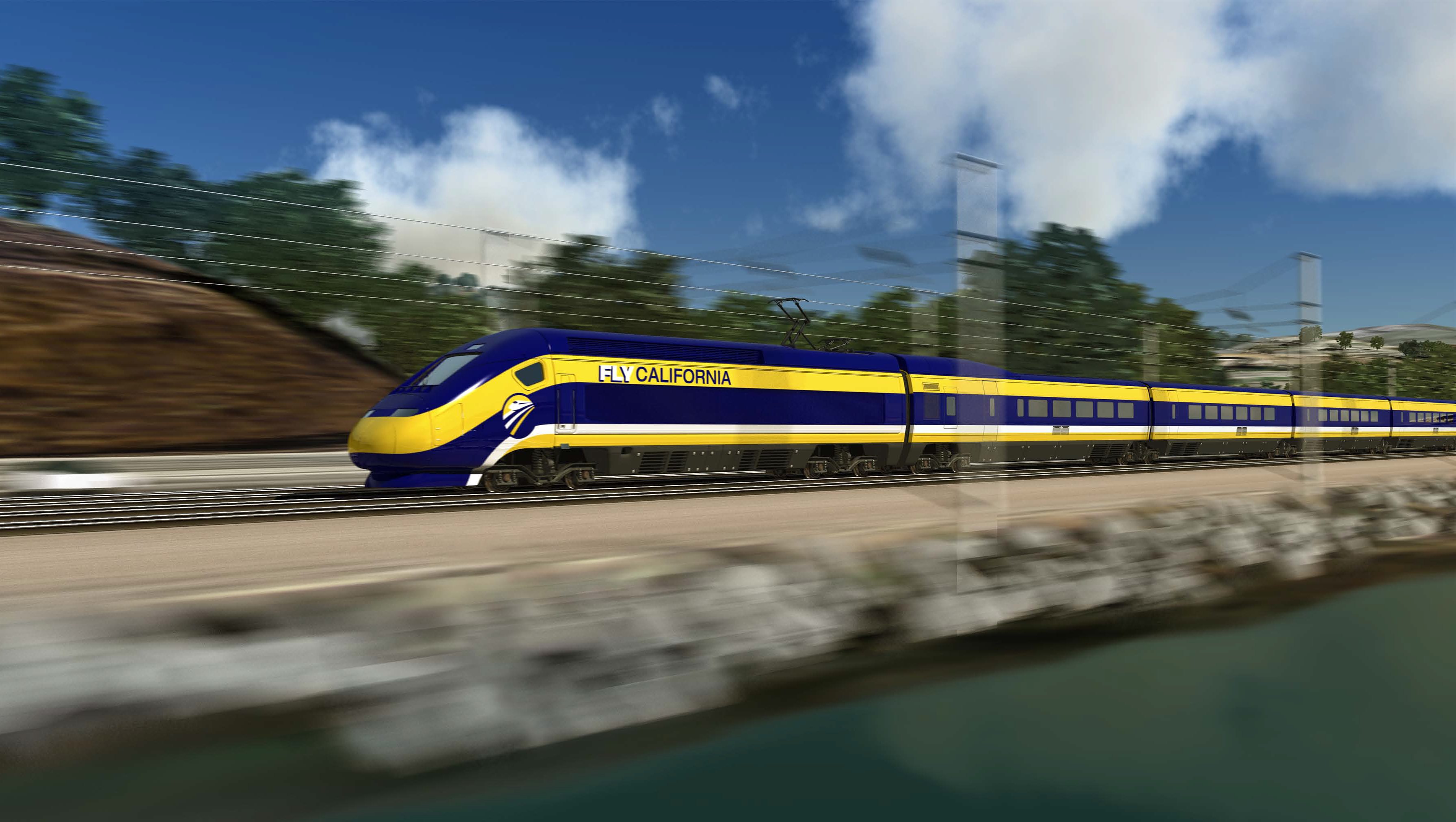 Sunday Train has covered the California HSR project on a number of occasions in the past. However, there was no special attention given to what was widely covered at the time as the “end of California HSR”, when a judge ruled that the proposed Business Plan did not meet the terms of the Prop1A(2008) which governed the sale of much of the $9m in state bond authority which had passed in 2008. The Sacramento Bee covered the issue at the time, including the appeal of the ruling to the Supreme Court.
Sunday Train has covered the California HSR project on a number of occasions in the past. However, there was no special attention given to what was widely covered at the time as the “end of California HSR”, when a judge ruled that the proposed Business Plan did not meet the terms of the Prop1A(2008) which governed the sale of much of the $9m in state bond authority which had passed in 2008. The Sacramento Bee covered the issue at the time, including the appeal of the ruling to the Supreme Court.
And the reason the Sunday Train did not cover that court judgement is IANDL (I Aint No Dang Lawyer), so I was waiting to see what actually happened with respect to funding for the project. And now it appears to me that funding for the original segment from north of Fresno to the outskirts of Bakersfield has been secured, with the news that part of the Budget deal has secured Cap and Trade funding for the HSR project.
More on what this means, below the fold.
Mar 10 2014
Sunday Train: Cap&Trade Funds should help finance the California HSR
An encore of a Sunday Train from 22 April, 2012, on a topic that has come back in the news
Burning the Midnight Oil for Living Energy Independence
 One element of the recent California HSR “revised” draft 2012 Business Plan (which we shall call the Other, Other Plan) involves looking to one particular means of finance in addition to general fund bond finance and Federal transport grant funding:
One element of the recent California HSR “revised” draft 2012 Business Plan (which we shall call the Other, Other Plan) involves looking to one particular means of finance in addition to general fund bond finance and Federal transport grant funding:
Cap-and-Trade Program Funds
Assembly Bill 32 (Statutes, 2006, Chapter 488) mandates a reduction of statewide greenhouse gas emissions to 1990 levels by 2020. In accordance with that law, California will implement a market-based cap-and-trade program. Funds from the program can be used to further the purposes of AB 32, including for development and construction of the high-speed rail system.
This has led to the current controversy in which the California Legislative Analysts Office, the LAO, has argued that the Cap and Trade funds might not be usable for HSR (pdf: p. 8).
One of their points, “Other GHG Reduction Strategies Likely to Be More Cost Effective,” involves a serious and common misframing of the question of the use of funds dedicated to reducing Greenhouse Gas Emissions: when reducing GHG emissions in a project that serves multiple purposes, the cost effectiveness of the GHG emissions spending depends on what share of the project funding is represented by that GHG emissions spending.
So more on transport, Green House Gas emissions, and the peculiar analytical weaknesses that crop up whenever the California LAO turns its attention to HSR, over the fold.
Sep 02 2013
Sunday Train: The Proposed Chicago – Fort Wayne – Columbus Rapid Rail Service
cross-posted from Voices on the Square
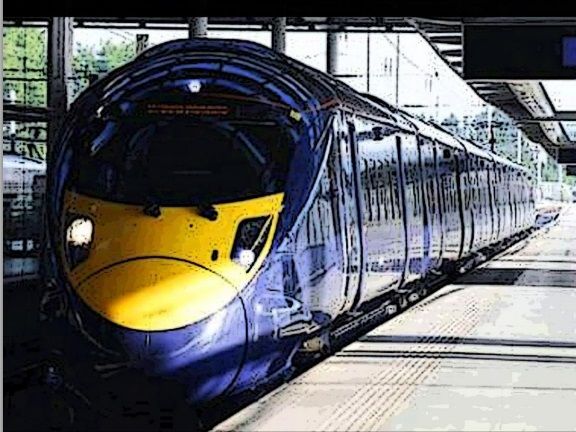 The Northeast Indiana Passenger Rail Association, on 28 June 2013, announced the results of their study of a Northern Indiana / Ohio rail corridor to Chicago:
The Northeast Indiana Passenger Rail Association, on 28 June 2013, announced the results of their study of a Northern Indiana / Ohio rail corridor to Chicago:
The proposed system would operate twelve trains each way per day, including at least six express schedules. With modern diesel equipment running at speeds of up to 110 miles per hour to start, the three-hundred mile trip between downtown Chicago and downtown Columbus would normally require only three hours, forty-five minutes (express service), or four hours (local service). Track and safety improvements in a potential future phase would support speeds up to 130 mph and a downtown Chicago to downtown Columbus express time of three hours, twenty minutes.
Longer time readers of the Sunday Train may recognize this as a piece of the Ohio Hub project, first developed in the 1990’s. At the time that the Ohio Hub was originally developed, the Fort Wayne to Chicago link was slated to be the second connection from Ohio to Chicago, with the envisioned phasing being:
- Phase 1: Chicago to Detroit; and Cincinnati – Columbus – Cleveland ~ the Triple C backbone of the Ohio Hub
- Phase 2: Cleveland to Toledo, Toledo to Detroit, completing Cleveland to Chicago via Michigan
- Phase 3: Fort Wayne to Chicago; Toledo to Fort Wayne; Columbus to Fort Wayne; Cincinnati – Indianapolis – Gary – Chicago, completing Dayton/Cincinnati to Chicago via Indianapolis and Columbus/Cleveland to Chicago via Fort Wayne
- Phase 4: Cleveland to Pittsburgh via Youngstown, connecting with services to Philadelphia / New York on the Keystone Corridor
- Phase 5: Columbus to Pittsburgh, connecting with services to Philadelphia / New York on the Keystone Corridor
- Phase 6: Cleveland to Toronto via Buffalo and Niagara Falls, connecting with services to New York and Boston on the Empire Corridor
So what the Northeast Indiana Passenger Rail Association is doing is pulling out a section of the Phase Three of the Ohio Hub and proposing it as a free-standing project. This free-standing project would bring intercity rail service back to Columbus, the largest or second largest urban area lacking rail service (depending on how you count Phoenix), and to Fort Wayne, the largest urban area in Indiana without intercity passenger rail service.
Oct 15 2012
Sunday Train: Is Big Oil Striking Back against the California Bullet Train vote?
Burning the Midnight Oil for Living Energy Independence
cross-posted from Voices on the Square
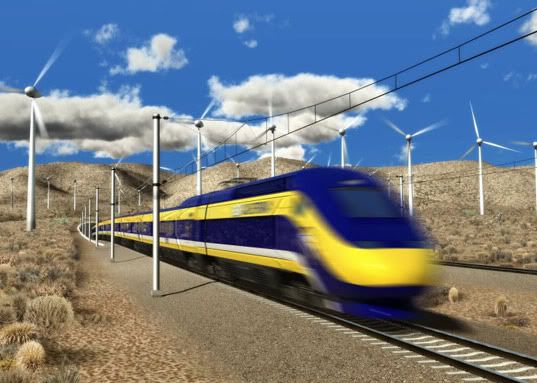 One of the biggest difficulties in the fight for sustainable energy independence is that Big Oil and Big Coal, the entrenched vested interests against our nation’s long term economic survival, have ample resources and ample practice in playing the long game. They have, over decades, built up a network of propaganda mills (Heritage, Cato, Reason), pro-corporate legislative cookie cutter factories (ALEC) and have invested heavily in buying large number of legislatures at both the state and federal level.
One of the biggest difficulties in the fight for sustainable energy independence is that Big Oil and Big Coal, the entrenched vested interests against our nation’s long term economic survival, have ample resources and ample practice in playing the long game. They have, over decades, built up a network of propaganda mills (Heritage, Cato, Reason), pro-corporate legislative cookie cutter factories (ALEC) and have invested heavily in buying large number of legislatures at both the state and federal level.
So we should not expect victories to come without an effort to strike back coming from Big Oil or Big Coal. It appear that this effort may be underway in California, following Big Oil’s big loss when the California State Legislature approved the California State funding to match the Federal Funding of the HSR Initial Construction Segment.
Aug 27 2012
Sunday Train: Neil Armstrong and an America that can do Great Things
Burning the Midnight Oil for Living Energy Independence
crossposted from Voices on the Square
 By now, you would likely have seen the headline that Neil Armstrong dies: First man on the moon passes away at 82, or something akin to it.
By now, you would likely have seen the headline that Neil Armstrong dies: First man on the moon passes away at 82, or something akin to it.
Among those who follow the space program more closely, many are aware that there are few pictures of Neil Armstrong on the Moon. Neil Armstrong had two and a half hours of moonwalks, and Neil Armstrong operated the main camera. The camera that Buzz Aldrin operated was used for technical assignments.
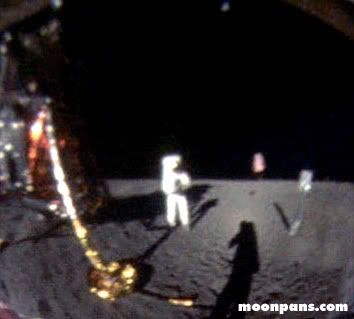 This fuzzy picture was take by enhancing a picture Neil took of Buzz Aldrin, and zooming in on the reflective visor, where Neil Armstrong appears in reflection as the photographer. And the small blue dot near the top?
This fuzzy picture was take by enhancing a picture Neil took of Buzz Aldrin, and zooming in on the reflective visor, where Neil Armstrong appears in reflection as the photographer. And the small blue dot near the top?
That’s Earth.
The passing of Neil Armstrong brought my mind back to the topic of An America that Can Do Great Things, and so I thought I would reprint my piece from 11 March, 2011, for this week’s Sunday Train, on the connection between HSR and an America That Can Do Great Things.
Jul 09 2012
Sunday Train: California Senate Approves High Speed Rail Construction
Burning the Midnight Oil for Living Energy Independence
Crossposted from its home station at Voices on the Square
Firedog Lake: California Legislature Passes High Speed Rail Bond Issue, Moving Project Forward ~ David Dayen
…
In a closely watched vote of the California state Senate, a bill to issue the first $5.8 billion in bonds for the construction of high speed rail lines passed 21-16. It needed all 21 votes to pass. Four Democrats voted no – including Allen Lowenthal, the Democratic candidate for Congress in CA-47, and Fran Pavley, the author of the state’s historic global warming law – but ultimately, just enough Democrats voted in favor of the bonds for them to pass. Joe Simitian and Mark DeSaulnier were the other Democrats who opposed the bill.
…
This does not end the battle for high speed rail. Between the bond issue and the federal money, that covers only about 1/5 of the total funding needed for the full project, which would connect Sacramento and San Diego and all points in between by high speed rail. But if this died today, you can be certain that nothing would ever get built. The federal government was prepared to take away the $3.2 billion in stimulus dollars earmarked for this stage of the project. And faith in the future of high speed rail in California – and indeed the nation – would have been sapped.
So … what now?
Jul 06 2012
High Speed Rail Vote In California
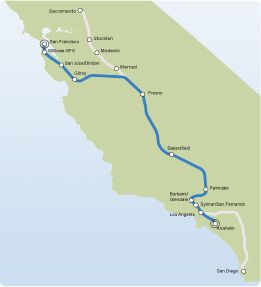
Up Date: 7:00 PM EDT The California High Speed Rail Bill has passed 21 – 16.
Today is the crucial vote for High Speed Rail project in the California State Senate. As, BruceMcF pointed out in this week’s Sunday Train, it all hinges on the Democrats.
In response to complaints, including from Senators (Joe) Simitian and (Alan) Lowenthal, that too much was being spent in the less heavily populated central valley, and not enough money was being spent in the more populous LA Basin and Bay Area, the revised Business Plan includes “early investment” in the bookends, to help prepare them for blended operation of HSR alongside more local rail services.
That early investment includes an agreement that will allow for the funding of the electrification of the Caltrain Corridor, serving Simitian’s own district, and key to the long term survival of the Caltrain service so that it is available for use when the next petroleum crisis hits.
But, going by the description of a Simitian staffer of his position, these changes may not have been enough to convince Simitian to switch to a position of support for actually building HSR.
The bill passed the Assembly and Gov. Jerry Brown has said that he will sign it but there are at least 6 Democratic hold outs. Since there all the Republicans are opposed and to pass the bill needs 21 of the 25 Democratic Senators, the funding totally hinges on these Senators.
The California state Assembly on Thursday approved an $8 billion high-speed rail financing plan that likely will face a tougher vote in the Senate over the system’s projected $68 billion cost and concerns about its management.
The project, expected to take decades to complete, has the backing of Democratic Governor Jerry Brown, who says a bullet train network will boost job creation and provide an alternative to car and plane travel in the country’s most populous state. [..]
If it is approved, California could begin selling bonds for the project and lock in federal funds for a line in the state’s Central Valley.
Senator Leland Yee, a Democrat from San Francisco, said the plan’s supporters have their work cut out winning him over, a sentiment other Democratic senators have shared with Reuters in recent days.
As David Dayen at FDL News notes, if the bill is not passed, California will lose the billions in promised funding for the project from the Federal government:
This is crucial, because the federal Department of Transportation has made clear that they will revoke their $4.3 billion in federal funds for California’s HSR project, most of which came out of the stimulus package, if the state doesn’t approve funding today. This would undoubtedly stall the project, perhaps permanently. And California is probably the furthest along of any state on a high speed rail system.
Building this leg of the system is crucial to transportation in the region, energy and fuel economy and it will create jobs in hard hit California. All of that should offset any negatives of bond funding, by increasing revenue brought in from more people workong and spending in California. Let’s hope a couple of these Democrats wake up and see the advantage to being at the forefront of a new transportation age.
Jul 02 2012
Sunday Train: Is State Sen. Simitian aiming to kill High Speed Rail in California?
Burning the Midnight Oil for Living Energy Independence
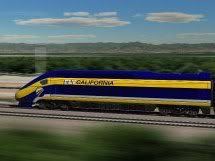 This coming week is supposed to contain an important symbolic Independence Day: the day when the California State Senate votes whether or not to proceed with one strategic element of Energy Independent Transport for the State of California, or whether to gamble the state’s future on petroleum.
This coming week is supposed to contain an important symbolic Independence Day: the day when the California State Senate votes whether or not to proceed with one strategic element of Energy Independent Transport for the State of California, or whether to gamble the state’s future on petroleum.
It is, of course, a very sure thing as a gamble ~ on the losing side. They aren’t making more, and the butane from natural gas liquids and energy inefficient production of ethanol from corn starch that has been used to juke the states on US “liquid fuel production” doesn’t change the fact that we still depend on petroleum imports for over half of our petroleum consumption. We deplete more and more low production cost petroleum every year, shifting our consumption to higher cost petroleum.
And even if we had the petroleum that Pollyannas would like to wish into existence, we can’t afford to burn it all at an accelerating rate, due to the CO2 emissions that will result.
State Senator Simitian does not seem to see it that way, as he appears set to vote kill the effort to allow the California High Speed Rail project to break ground next year.
Now, in an wonderful display of political pretzel logic, State Senator Simitian threatens to kill the HSR project will declaring his strong support of it: it will all be someone else’s fault if he votes to refuse to break ground next year.
- 1
- 2

Recent Comments